Effectiveness of Urban Mobility Decarbonization Instruments
Abstract
1. Introduction
2. Research Characteristics
2.1. Literature Review
2.2. Characteristics of Empirical Research on Mobility in Agglomeration Areas
- -
- How will urban mobility models change in the future? This question was verified based on the study of the behavior of the creative class.
- -
- How can shock situations such as the COVID-19 pandemic affect mobility behavior and future mobility patterns?
2.3. Electromobility Research
3. Application to Case Studies on Urban Mobility
3.1. Mobility of the Creative Class
3.2. Mobility under Conditions of Movement Restrictions
3.3. Mobility Using Electromobility
- -
- implementation of appropriate selection of routes for electric buses, so that the current timetable can be efficiently implemented, which should be a reference point for all solved problems; achieving satisfactory results from the point of view of the passenger, public transport organizer and operators requires resolutions on issues related to
- ○
- the structure of the bus fleet in terms of the type of drive, including the share of buses with diesel drive, battery drive, or a fleet consisting only of electric buses,
- ○
- maintaining the existing network of routes and bus lines and the timetable or making changes resulting from the structure of the bus fleet;
- -
- determination of the optimal location of battery charging devices, assuming the implementation of the given operational plan, i.e., the network of routes and bus lines and the timetable, as well as taking into account the battery discharge process as a function of the following factors:
- ○
- driving time,
- ○
- ascents and descents of bus routes,
- ○
- driving conditions, including, i.e., the number of stops and starts caused by congestion or traffic lights,
- ○
- energy demand of on-board equipment, in particular heating and air conditioning systems;
- -
- development of an optimal strategy for supplying buses with energy on the route, which requires resolving issues regarding battery charging or battery replacement.
4. Key Research Findings
- -
- Public transport is treated as the second choice for meeting mobility needs after the passenger car. This primary importance of a passenger car is confirmed by the results of research in which respondents largely do not accept the restrictive instruments of transport policy, especially the parking policy.
- -
- The main advantage of the passenger car in the examined agglomerations is the shorter travel time. Public transport still offers less accessibility and longer door-to-door travel times. This situation is aggravated by the extension of travel distances caused by deglomeration and the urban sprawl process, as well as low unemployment, which are associated with an increase in the scope of the labor market, thus extending the distance to the workplace.
- -
- The basic factors for increasing the competitiveness and efficiency of collective transport as a decarbonization tool, apart from ticket price reductions, are higher frequency of departures, expansion of the network of connections and stops—that is, above all, availability in time and space.
- -
- Restrictive measures of the transport policy limiting the use of a passenger car are accepted provided that restrictive measures are combined with incentive measures that shorten the travel time by public transport, increase the spatial accessibility of stops, increase the directness of connections, support the development of zero-emission delivery systems for collective transport, and, finally, reduce ticket prices for collective transport.
- -
- Bicycles and means of personal transport are rated well by the respondents, but they are used mainly for recreational trips and to a lesser extent for everyday mobility. The condition for an increase in the share of bicycles in the mobility service in urban agglomeration areas is the improvement of infrastructure and facilitations in terms of parking bicycles and preparing commuters to work in this way. Much less is known about scooters, which seem to be used more for transport than recreationally.
- -
- The great potential for decarbonization results from limiting physical mobility and replacing it with cybermobility. The period of the COVID-19 pandemic showed great opportunities in such activities. For example, in the city of Katowice, during the greatest lockdown restrictions, the volume of car traffic decreased by 1/3. The introduction of remote work and learning, as well as the hybrid model, reduces physical mobility, and thus reduces greenhouse gas emissions. It should be remembered that cybermobility also causes such emissions, but on a much smaller scale. The latest research of office workers conducted in 2022 by CISCO covering 27 countries and 28,000 employees [45] shows a sustained increase in expectations regarding the maintenance of remote work, and it seems that such expectations will increase. In addition, preliminary (pilot) studies [46] in Upper Silesian and Zagłębie Metropolis (GZM) indicate that synergistic factors in planning cybermobility are the results of research on objective and subjective personal factors of people related to a specific activity, especially in terms of the attitude of these people to the virtualization of a specific activity, e.g., to introduce remote work and hybrid work along with flexible working hours and to assess the susceptibility of professional duties to remote work using modern ITC technologies (Information and Communication Technologies).
- -
- The calculation of the costs of electromobility in the case of city buses shows that this solution is effective only under certain conditions: changes in the energy mix, organization of transport ensuring the use of the potential of the electric bus on routes with an appropriate longitudinal profile, appropriate charging network. In addition, the type and size of the batteries used in connection with the organization of service by vehicles have an impact on the efficiency; in particular, it is about limiting or eliminating the replacement of batteries during the life cycle of a bus and a passenger car.
- -
- One of the negative effects of the pandemic was the deterioration of the competitive position of urban collective transport. In the city of Katowice, which is the center of the urban agglomeration, the share of public transport in handling mobility during the pandemic decreased by as much as nine percentage points in favor of the passenger car, as well as pedestrian movements. According to data from public transport organizers, the share of this system in modal split is currently returning to pre-pandemic levels, which is the result of economic recovery, as well as probably also due to a large number of people arriving to Poland from Ukraine as a result of the war that is taking place there.
5. Discussion
6. Conclusions
Author Contributions
Funding
Institutional Review Board Statement
Informed Consent Statement
Data Availability Statement
Conflicts of Interest
References
- Kos, B.; Krawczyk, G.; Tomanek, R. Modelowanie Mobilności Miejskiej (In English: Modeling Mobility in Cities); House of the University of Economics in Katowice: Katowice, Poland, 2018. [Google Scholar]
- Kos, B.; Krawczyk, G.; Tomanek, R. Key instruments of sustainable urban mobility on the example of the Silesian Metropolis. In Modelling of the Interaction of the Different Vehicles and Various Transport Modes; Sładkowski, A., Ed.; Springer: Cham, Switzerland, 2020; pp. 289–332. [Google Scholar]
- Kos, B.; Krawczyk, G.; Tomanek, R. Inkluzywna Mobilność w Metropoliach (In English: Inclusive Mobility in Metropolises); Publishing House of the University of Economics in Katowice: Katowice, Poland, 2020. [Google Scholar]
- Kos, B.; Krawczyk, G.; Mercik, A.; Tomanek, R. Mobilność Miejska w Czasie Pandemii COVID-19 (In English Urban Mobility during the COVID-19 Pandemic); Publishing House of the University of Economics in Katowice: Katowice, Poland, 2021. [Google Scholar]
- Planning and Design for Sustainable Urban Mobility. Global Report on Human Settlements 2013, Routledge UN-Habitat 2015. Available online: https://unhabitat.org/sites/default/files/download-manager-files/Planning%20and%20Design%20for%20Sustainable%20Urban%20Mobility.pdf (accessed on 9 February 2023).
- Manville, C.; Cochrane, G.; Cave, J.; Millard, J.; Millard, J.K.; Thaarup, R.K.; Liebe, A.; Wissner, M.; Massink, R.; Kotterink, B. Mapping Smart Cities in the EU, EPRS: European Parliamentary Research Service. 2014. Available online: http://www.europarl.europa.eu/RegData/etudes/etudes/join/2014/507480/IPOL-ITRE_ET(2014)507480_EN.pdf (accessed on 9 February 2023).
- Barometer of the Association of European Metropolitan Transport Authorities (EMTA). 11th edition, CRTM Madrid, Paris 2017. Available online: http://www.emta.com/spip.php?article267&lang=en (accessed on 9 February 2023).
- Cuthbert, A.R. The Form of Cities. In Political Economy and Urban Design; Blackwell Publishing: Hoboken, NJ, USA, 2006. [Google Scholar]
- Szołtysek, J. Kreowanie Mobilności Mieszkańców Miast (In English: Creating the Mobility of Urban Residents); Wolters Kluwer: Warszawa, Poland, 2011. [Google Scholar]
- Brdulak, A.; Brdulak, H. Smart city solutions in regard to urbanization processes-Polish cases. Logist. Sustain. Transp. 2015, 6, 50–60. Available online: https://core.ac.uk/download/pdf/132120553.pdf (accessed on 9 February 2023). [CrossRef]
- Felson, M.; Spaeth, J.L. Community structure and collaborative consumption: A routine activity approach. Am. Behav. Sci. 1978, 21, 614–624. [Google Scholar] [CrossRef]
- Wyszomirski, O. Zrównoważony rozwój miejskiego transport zbiorowego–przykład Gdyni (in English: Sustainable development of urban collective transport-the example of the city of Gdynia). Transp. Miej. Reg. 2014, 4, 4–9. [Google Scholar]
- Hebel, K.; Wyszomirski, O. Plan zrównoważonej mobilności miejskiej jako kompleksowe podejście do planowania mobilności w miastach (in English: Sustainable Urban Mobility Plan as a comprehensive approach to urban mobility planning). Autobusy Tech. Eksploat. Syst. Transp. 2014, 15, 28–31. [Google Scholar]
- Florida, R. The Rise of the Creative Class: And How It’s Transforming Work, Leisure, Community and Everyday Life; Hachette Book Group: New York, NY, USA, 2002. [Google Scholar]
- Florida, R. Cities and the Creative Class. City Community 2003, 2, 3–19. [Google Scholar] [CrossRef]
- Marshall, S.; Banister, D. Travel Reduction Strategies: Intentions and Outcomes. Transp. Res. Part A 2000, 34, 321–338. [Google Scholar] [CrossRef]
- Wolański, M. Ocena skuteczności polskich polityk mobilności miejskiej (in English: Assessment of the effectiveness of Polish urban mobility policies). Transp. Miej. Reg. 2022, 8, 23–27. [Google Scholar]
- Barłomiejczyk, M.; Połom, M. Wybrane uwarunkowania eksploatacyjne i energetyczne autobusów elektrycznych i trolejbusów (in English: Selected operational and energy conditions of electric buses and trolleybuses). Transp. Miej. Reg. 2022, 8, 28–32. [Google Scholar]
- Weidmann, N.; Salunkhe, S.; Anjorin, A.; Yigitbas, E.; Engels, G. Automating Model Transformations for Railway Systems Engineering. J. Object Technol. 2021, 20, 10–11. [Google Scholar] [CrossRef]
- Umiliacchi, S.; Bhatia, D.; Brownlee, A.; Brown, C. Enterprise architecture within railway systems engineering. IET Intell. Transp. Syst. 2019, 13, 1461–1467. [Google Scholar] [CrossRef]
- Baek, Y.G.; Lee, J.C. Railway Systems Development Based on the Concept of Systems Engineering and Safety: A Case Study of Railway Industry Practices. Int. J. Eng. Sci. (IJES) 2017, 6, 18–29. [Google Scholar]
- Karoń, G.; Janecki, R.; Mikulski, J. Selected issues of systems engineering methodology in the design of transport systems. Transp. Technol. 2022, 3, 85–101. [Google Scholar] [CrossRef]
- Janecki, R.; Karoń, G.; Mikulski, J. Telematic Applications for the Metropolitan Railway System (MR) in the Górnośląsko-Zagłębiowska Metropolis. In Development of Transport by Telematics. TST 2019. Communications in Computer and Information Science; Mikulski, J., Ed.; Springer: Cham, Switzerland, 2019; Volume 1049. [Google Scholar] [CrossRef]
- Baum, H.J. Free public transport. J. Transp. Econ. Policy 1973, 7, 3–19. [Google Scholar]
- Fearnley, N. Free fares policies: Impact on public transport mode share and other transport policy goals. Int. J. Transp. 2013, 1, 75–90. [Google Scholar] [CrossRef]
- De Witte, A.; Macharis, C.; Mairesse, O. How persuasive is ‘free’ public transport? A survey among commuters in the Brussels Capital Region. Transp. Policy 2008, 15, 216–224. [Google Scholar] [CrossRef]
- Tomanek, R. Free fare public transport in the concept of sustainable urban mobility. Transp. Probl. 2017, 12, 95–105. [Google Scholar] [CrossRef]
- Krawiec, K.; Karoń, G.; Czogalla, O.; Kovalyov, M.; Cebrat, G. Selected functionalities of the PLATON Planning Tool to support electric bus deployment in transport networks. In Proceedings of the TRA2020, the 8th Transport Research Arena: Rethinking Transport-Towards Clean and Inclusive Mobility, Helsinki, Finland, 27–30 April 2020; Lusikka, T., Ed.; T. 7. Traficom Research Reports. Finnish Transport and Communications Agency Traficom: Helsinki, Finland, 2020; pp. 1–11. [Google Scholar]
- Karoń, G. Energy in Smart Urban Transportation with Systemic Use of Electric Vehicles. Energies 2022, 15, 5751. [Google Scholar] [CrossRef]
- Izdebski, M.; Jacyna, M. An Efficient Hybrid Algorithm for Energy Expenditure Estimation for Electric Vehicles in Urban Service Enterprises. Energies 2021, 14, 2004. [Google Scholar] [CrossRef]
- Turoń, K.; Kubik, A.; Chen, F.; Wang, H.; Łazarz, B. A Holistic Approach to Electric Shared Mobility Systems Development—Modelling and Optimization Aspects. Energies 2020, 13, 5810. [Google Scholar] [CrossRef]
- Burchart-Korol, D.; Jursova, S.; Folęga, P.; Pustejovska, P. Life cycle impact assessment of electric vehicle battery charging in European Union countries. J. Clean. Prod. 2020, 257, 120476. [Google Scholar] [CrossRef]
- Komsiyska, L.; Buchberger, T.; Diehl, S.; Ehrensberger, M.; Hanzl, C.; Hartmann, C.; Hölzle, M.; Kleiner, J.; Lewerenz, M.; Liebhart, B.; et al. Critical Review of Intelligent Battery Systems: Challenges, Implementation, and Potential for Electric Vehicles. Energies 2021, 14, 5989. [Google Scholar] [CrossRef]
- Karoń, G. Safe and Effective Smart Urban Transportation—Energy Flow in Electric (EV) and Hybrid Electric Vehicles (HEV). Energies 2022, 15, 6548. [Google Scholar] [CrossRef]
- Krawiec, K.; Karoń, G.; Kłos, M.J.; Wierzbicki, Ł. Selected issues of the TCO model for the conversion of the conventional bus to electric one. Transp. Commun. Sci. J. 2019, 7, 34–38. [Google Scholar] [CrossRef]
- Karoń, G.; Żochowska, R. Problems of quality of public transportation systems in smart cities-smoothness and disruptions in urban traffic. In Modelling of the Interaction of the Different Vehicles and Various Transport Modes; Sładkowski, A., Ed.; Lecture Notes in Intelligent Transportation and Infrastructure: Gliwice, Poland, 2020; pp. 383–414. [Google Scholar] [CrossRef]
- Krawiec, S.; Karoń, G.; Janecki, R.; Sierpiński, G.; Krawiec, K.; Markusik, S. Economic conditions to introduce the battery drive to busses in the urban public transport. In Proceedings of the 6th Transport Research Arena: TRA2016, Warsaw, Poland, 18–21 April 2016; pp. 2630–2639. [Google Scholar] [CrossRef]
- Janecki, R.; Karoń, G. Concept of Smart Cities and Economic Model of Electric Buses Implementation. In Telematics—Support for Transport; Mikulski, J., Ed.; Communications in Computer and Information Science; Springer: Berlin/Heidelberg, Germany, 2014; Volume 471, pp. 100–109. [Google Scholar]
- Krawiec, S.; Łazarz, B.; Markusik, S.; Karoń, G.; Sierpiński, G.; Krawiec, K.; Janecki, R. Urban public transport with the use of electric buses development tendencies. Transp. Probl. 2016, 11, 127–137. [Google Scholar] [CrossRef]
- Cycling Data, ECF. 2022. Available online: https://ecf.com/cycling-data/italy?field_cd_country_region_tid=1662 (accessed on 22 May 2022).
- Badanie Pilotażowe Zachowań Komunikacyjnych Ludności w Polsce (In English: Pilot Study of the Transport Behavior of the Population in Poland), GUS, Warszawa. 2015. Available online: https://stat.gov.pl/statystyki-eksperymentalne/uslugi-publiczne/badanie-pilotazowe-zachowan-komunikacyjnych-ludnosci-w-polsce-popt-2007-2013,14,1.html (accessed on 26 September 2022).
- European Environment Agency. The First and Last Mile—The Key to Sustainable Urban Transport. In Transport and Environment Report 2019; EEA: Copenhagen, Denmark, 2019; p. 46. Available online: https://www.eea.europa.eu/publications/the-first-and-last-mile (accessed on 22 May 2022).
- Czerniak, A.; Bojęć, T. W biurze 2022. Nowa Normalność (In English: In the Office 2022. The New Normal); Polska Izba Nieruchomość Komercyjnych i Polityka Insight: Warszawa, Poland, 2021; pp. 22–39. Available online: https://g.infor.pl/p/_files/37295000/poradnik-w-biurze-2022-polska-izba-nieruchomosci-komercyjnych-37295429.pdf (accessed on 22 May 2022).
- Colli, E.; Kuster, F.; Żganec, M. The State of National Cycling Strategies in Europe (2021), ECF. 2022. Available online: https://ecf.com/files/reports/national-cycling-strategies-in-europe-2021 (accessed on 22 May 2022).
- Cisco Global Hybrid Work Study 2022. Employees Are Ready for Hybrid Work, Are You? 2022. Available online: https://www.cisco.com/c/dam/m/en_us/solutions/global-hybrid-work-study/reports/cisco-global-hybrid-work-study-2022.pdf (accessed on 9 February 2023).
- Karoń, G.; Meskhishvili, D. Personal factors in mobility planning with virtual activities. Transp. Probl. 2023, 18. sent to the editorial office and now in print. [Google Scholar]
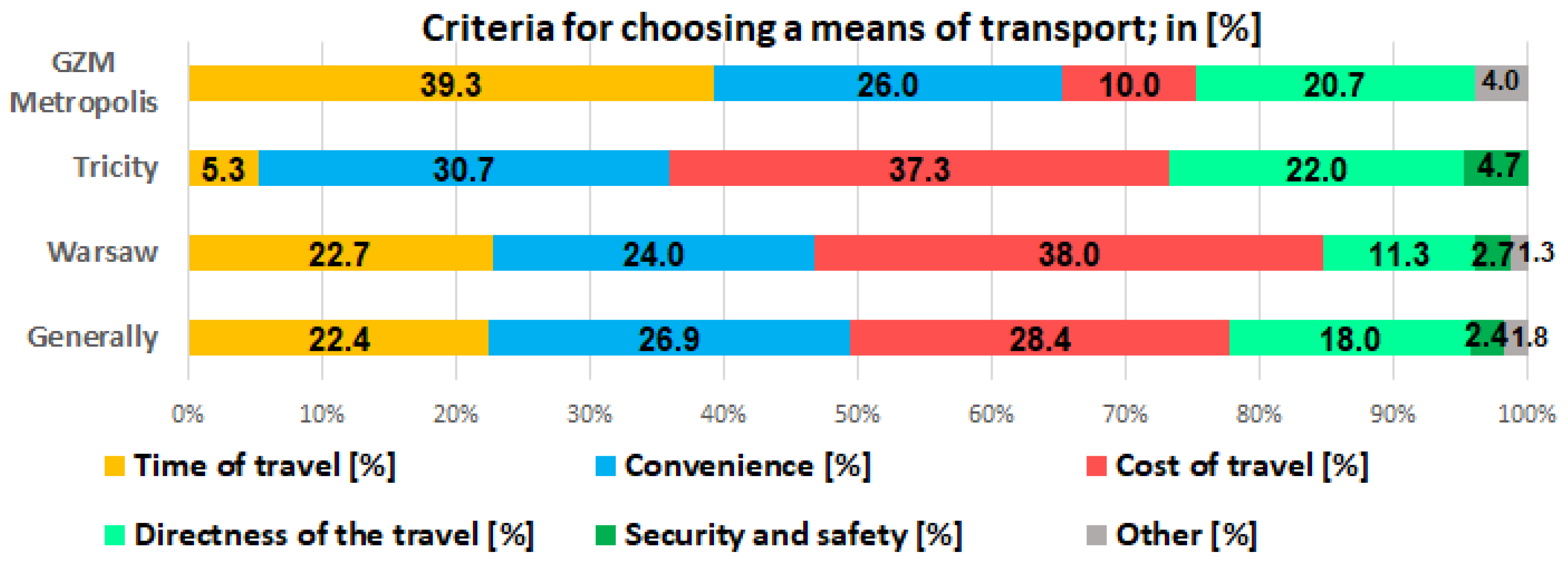

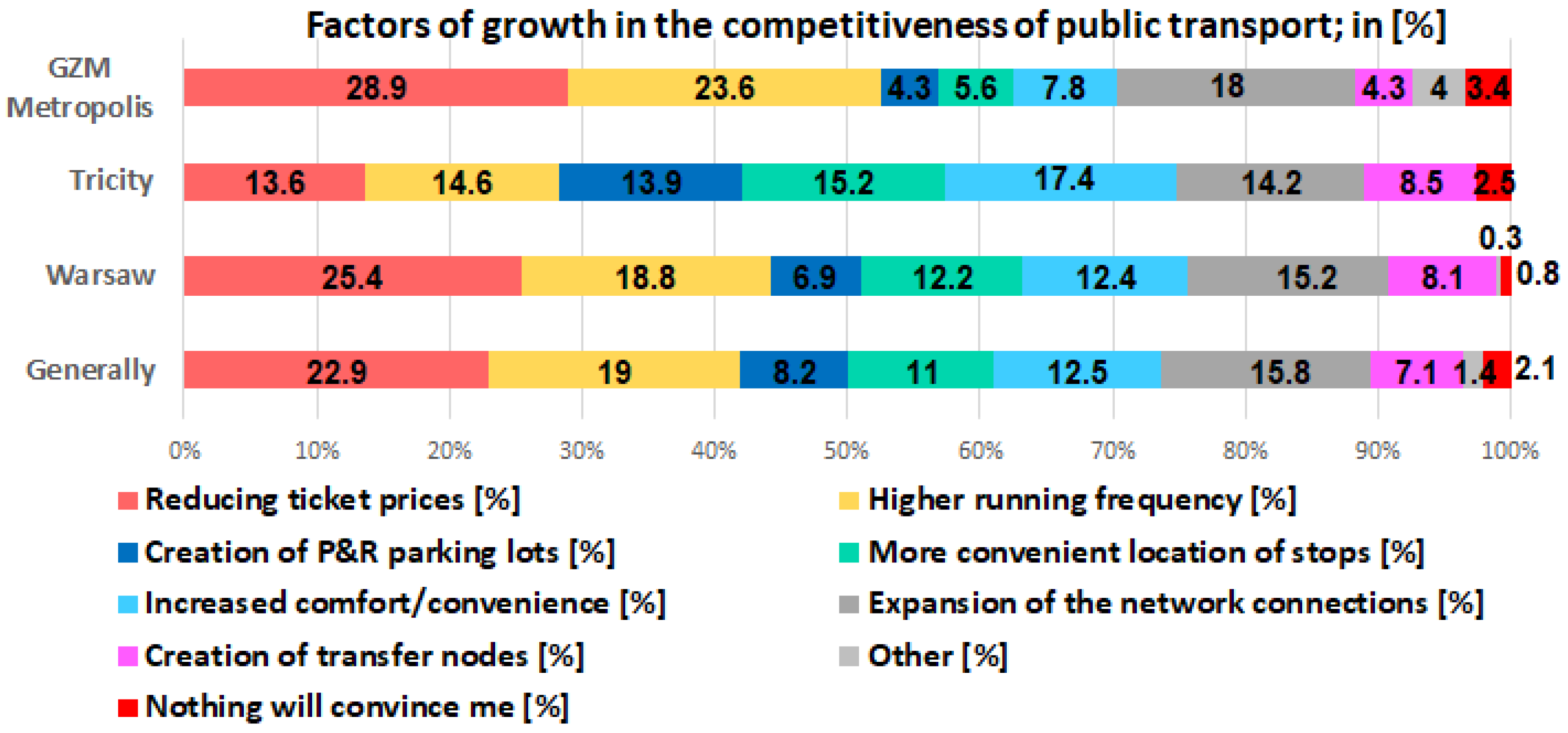
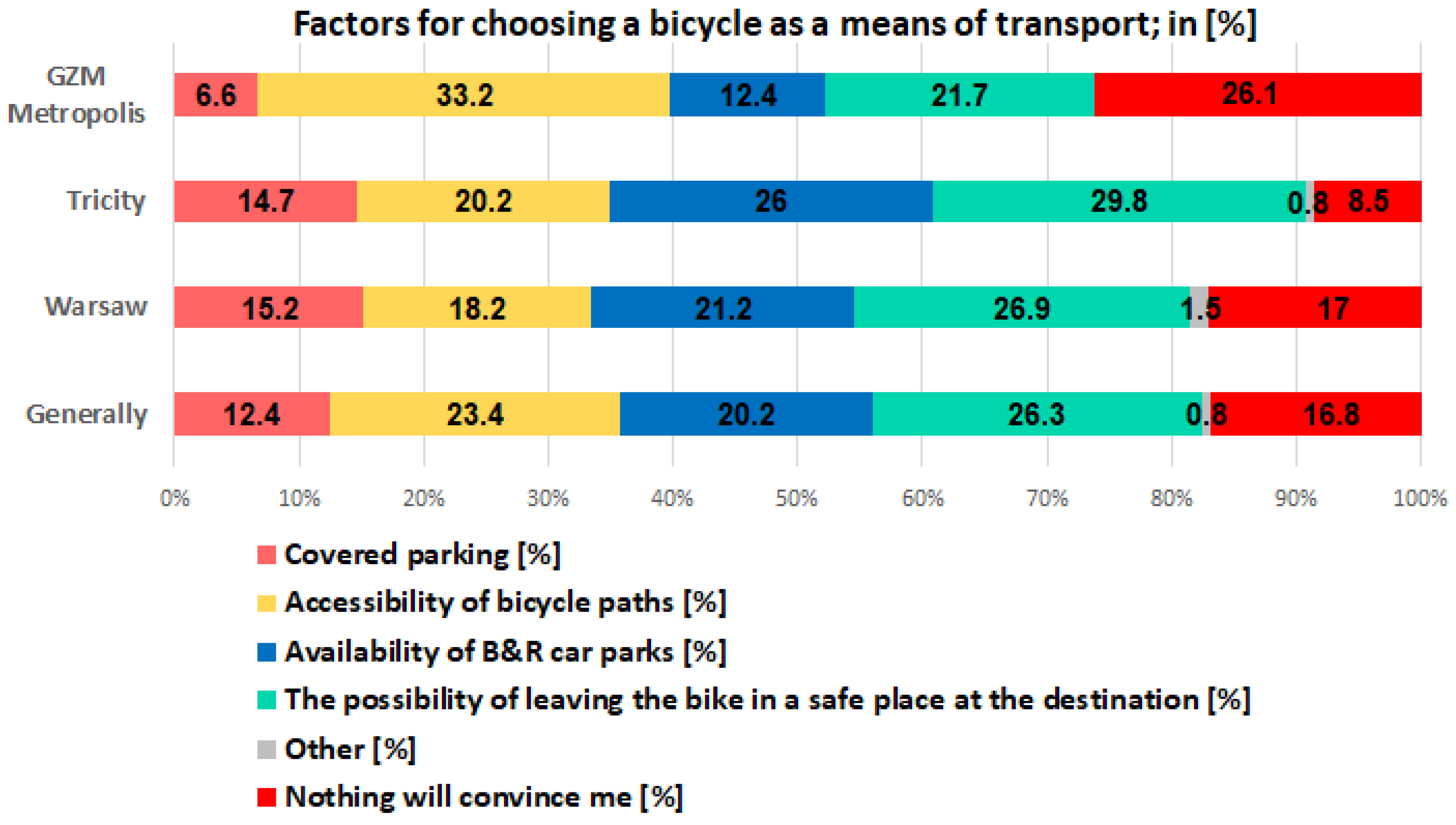
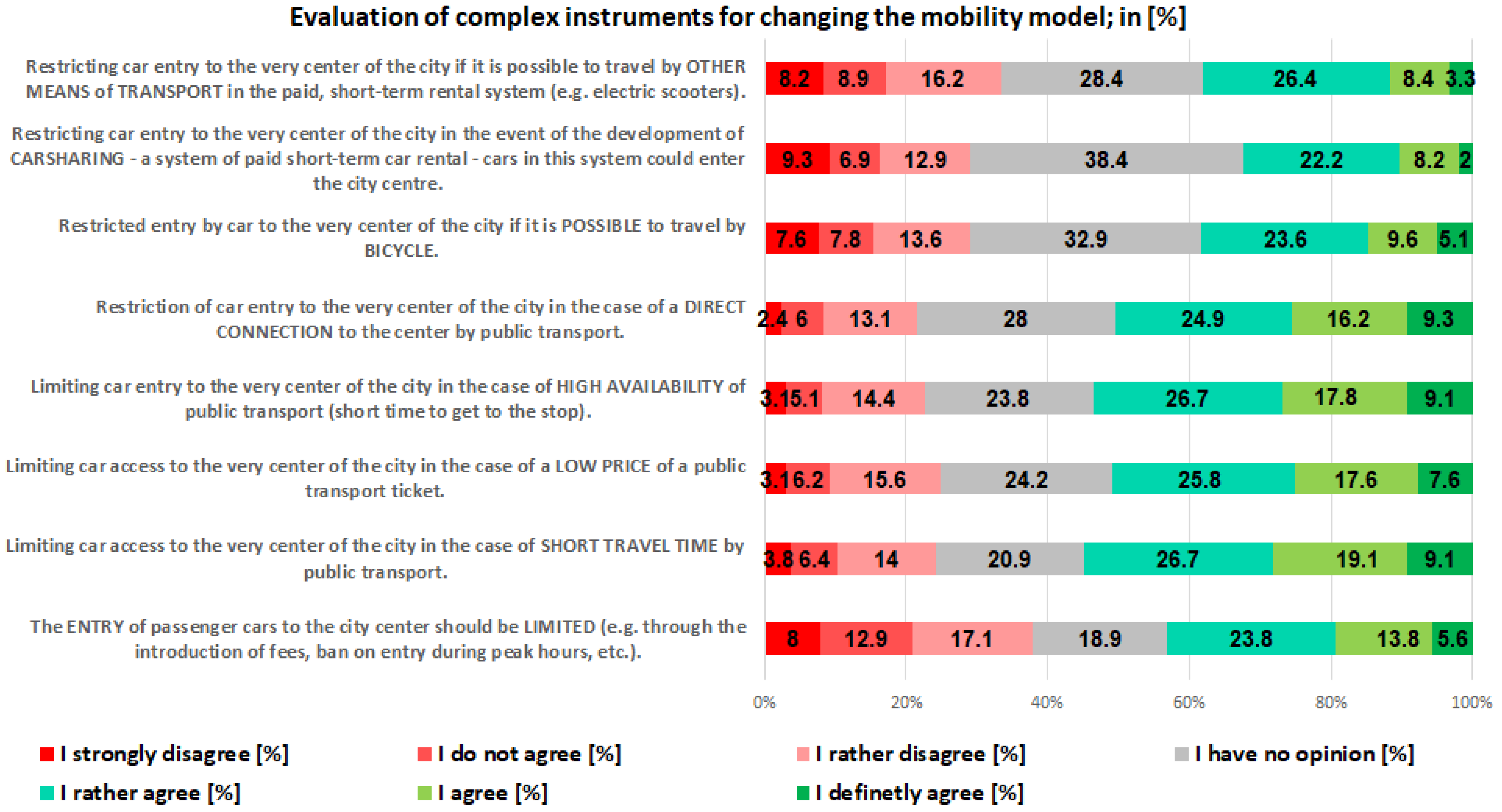
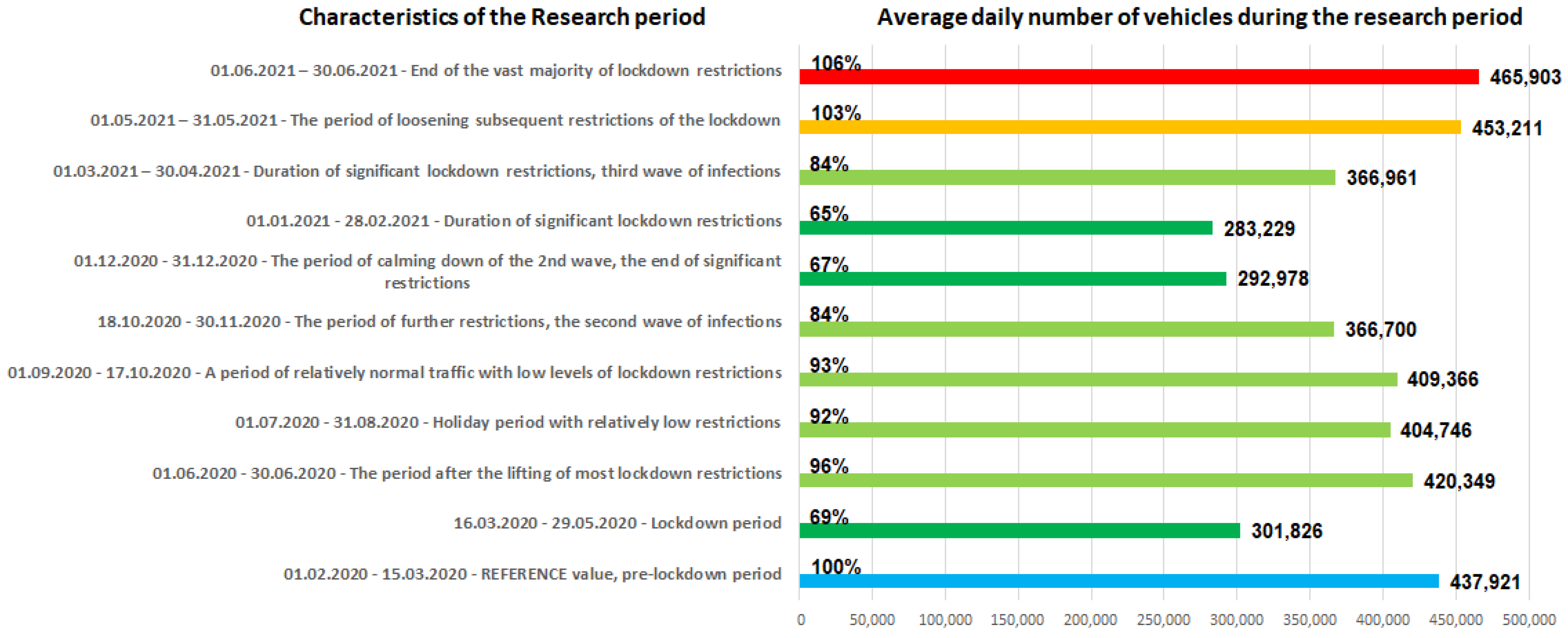
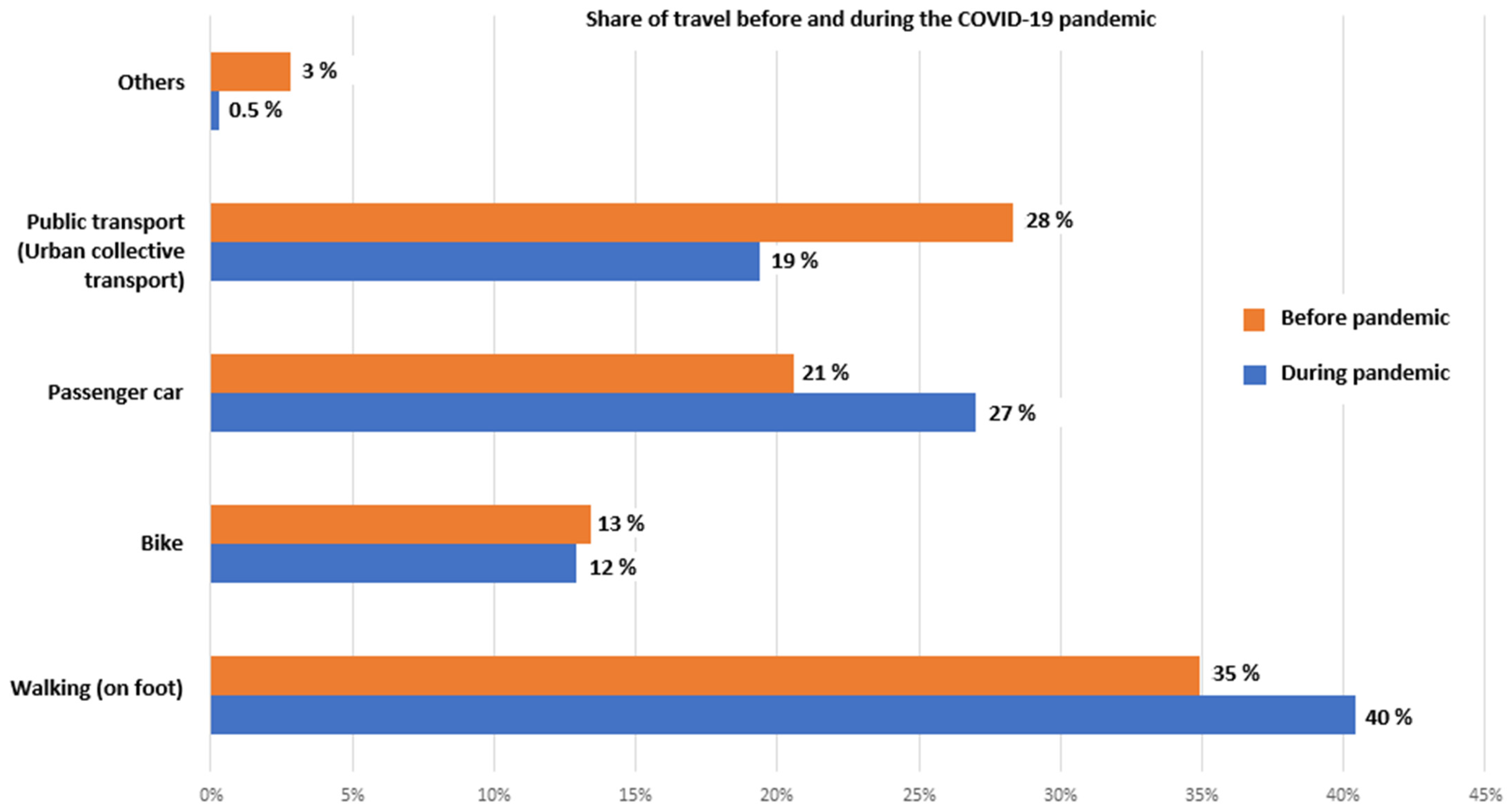

| The Scope of Data | Daily Distance [km] | Average Trip Distance [km] | Average Daily Distance [km] |
|---|---|---|---|
| Generally | 12,109 | 11.60 | 26.91 |
| Warsaw | 3345 | 9.53 | 22.30 |
| Tri-City | 3711 | 11.38 | 24.74 |
| GZM Metropolis | 5033 | 13.77 | 33.69 |
| Katowice City District | Śródmieście | Os. Paderewskiego—Muchowiec | Koszutka | Bogucice | Załęże |
|---|---|---|---|---|---|
| 1st half of 2019 | 9787 | 6624 | 5071 | 5627 | 5379 |
| 1st half of 2020 | 6625 | 4614 | 3728 | 4716 | 4432 |
| Changes | −32.3% | −30.3% | −26.5% | −16.2% | −17.6% |
| Katowice city district | Os. Witosa | Osiedle Tysiąclecia | Dąb | Wełnowiec-Józefowiec | Załęska Hałda—Brynów |
| 1st half of 2019 | 5784 | 7486 | 4398 | 7190 | 6279 |
| 1st half of 2020 | 4114 | 6290 | 3264 | 4485 | 4365 |
| Changes | −28.9% | −16.0% | −25.8% | −37.6% | −30.5% |
| Katowice city district | Brynów—Osiedle Zgrzebnioka | Ligota—Panewniki | Zawodzie | Dąbrówka Mała | Szopienice—Burowiec |
| 1st half of 2019 | 4752 | 9196 | 5059 | 4688 | 5949 |
| 1st half of 2020 | 3256 | 7130 | 4156 | 2724 | 4415 |
| Changes | −31.5% | −22.5% | −17.8% | −41.9% | −25.8% |
| Katowice city district | Janów—Nikiszowiec | Giszowiec | Murcki | Piotrowice—Ochojec | Zarzecze |
| 1st half of 2019 | 5037 | 6357 | 3898 | 7414 | 4013 |
| 1st half of 2020 | 3431 | 4788 | 2858 | 6175 | 2583 |
| Changes | −31.9% | −24.7% | −26.7% | −16.7% | −35.6% |
| Katowice city district | Kostuchna | Podlesie | Totally (Sum) | ||
| 1st half of 2019 | 5747 | 4403 | 130138 | ||
| 1st half of 2020 | 3958 | 3125 | 95232 | ||
| Changes | −31.1% | −29.0% | −26.8% |
Disclaimer/Publisher’s Note: The statements, opinions and data contained in all publications are solely those of the individual author(s) and contributor(s) and not of MDPI and/or the editor(s). MDPI and/or the editor(s) disclaim responsibility for any injury to people or property resulting from any ideas, methods, instructions or products referred to in the content. |
© 2023 by the authors. Licensee MDPI, Basel, Switzerland. This article is an open access article distributed under the terms and conditions of the Creative Commons Attribution (CC BY) license (https://creativecommons.org/licenses/by/4.0/).
Share and Cite
Karoń, G.; Tomanek, R. Effectiveness of Urban Mobility Decarbonization Instruments. Energies 2023, 16, 1833. https://doi.org/10.3390/en16041833
Karoń G, Tomanek R. Effectiveness of Urban Mobility Decarbonization Instruments. Energies. 2023; 16(4):1833. https://doi.org/10.3390/en16041833
Chicago/Turabian StyleKaroń, Grzegorz, and Robert Tomanek. 2023. "Effectiveness of Urban Mobility Decarbonization Instruments" Energies 16, no. 4: 1833. https://doi.org/10.3390/en16041833
APA StyleKaroń, G., & Tomanek, R. (2023). Effectiveness of Urban Mobility Decarbonization Instruments. Energies, 16(4), 1833. https://doi.org/10.3390/en16041833







